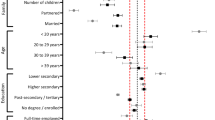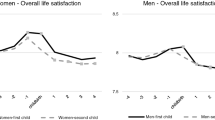Abstract
This paper examines the relationship between pregnancy and life satisfaction for US women of childbearing age using a large sample from the 2005 to 2009 waves of the Behavioral Risk Factor Surveillance System. The results show strong differences by race and ethnicity. Pregnancy has a significant positive correlation with happiness for Whites and Hispanics, but no relationship for Blacks. This differential in the marginal effect of pregnancy is in addition to a general decrease in satisfaction for Black women, independent of being pregnant. The results cannot be explained by differences in other demographics such age, income, education, or physical health status. Within each racial/ethnic group, the results are consistent across different categories for all these characteristics. Racial and ethnic differences in the effects of pregnancy on support from others can partly explain this result. For Whites and Hispanic women, pregnancy increases their feelings of social and emotional support from others, while pregnant Black women report lower levels of social and emotional support than non-pregnant Black women.
Similar content being viewed by others
Notes
An alternative would be to have the following mutually exclusive groups: white non-Hispanic, white Hispanic, blacks, Asians, Native Americans, and “other” (with each of the non-white groups including both Hispanics and non-Hispanics). Because the overwhelming majority of Hispanics in this sample categorize themselves as being either white or “other race”, the choice of categorization does not alter the results of the paper.
This is comparable with pregnancy rates for women between 18 and 45 in the 2006–2010 waves of the National Survey of Family Growth.
In 2006, the average age of mother for first birth was 22.7 years for black mothers, compared to 26.0 and 23.1 for white and Hispanic mothers, respectively (U.S. Department of Health and Human Services, Centers for Disease Control and Prevention, National vital Statistics Report, Volume 57, Number 7, January 2009).
References
Aquilino, M. L., & Losch, M. E. (2005). Across the fertility lifespan: Desire for pregnancy at conception. MCN The American Journal of Maternal/Child Nursing, 30(4), 256–262.
Ballas, D., & Dorlin, D. (2007). Measuring the impacts of major life events upon happiness. International Journal of Epidemiology, 36(6), 1244–1252.
Blake, S. M., Kiely, M., Gard, C. C., Ayman, A. E., El-Mohandes, A., & El-Khorazaty, M. N. (2007). Pregnancy intentions and happiness among pregnant black women at high risk for adverse infant health outcomes. Perspectives on Sexual and Reproductive Health, 39(4), 194–205.
Blanchflower, D. (2009a). International evidence on well-being. In A. B. Krueger (Ed.), National time accounting and subjective well-being (pp. 155–226). Chicago: University of Chicago Press.
Blanchflower, D. (2009b). Happiness and health care coverage. Dartmouth College, Mimeo.
Blanchflower, D., & Oswald, A. (2008). Is well-being U-shaped over the life cycle? Social Science and Medicine, 66(6), 1733–1749.
Canady, R. B., Bullen, B. L., Holzman, C., Broman, C., & Tian, Y. (2008). Discrimination and symptoms of depression in pregnancy among African American and white women. Women’s Health Issues, 18(4), 292–300.
Clark, A. E., Diener, E., Georgellis, Y., & Lucas, R. E. (2008). Lags and leads in life satisfaction: A test of the baseline hypothesis. The Economic Journal, 118(529), F222–F243.
Clark, A. E., & Georgellis, Y. (2013). Back to baseline in Britain: Adaptation in the British Household Panel Survey. Economica, 80(319), 496–512.
Clark, A. E., & Oswald, A. J. (2002). A simple statistical method for measuring how life events affect happiness. International Journal of Epidemiology, 31(6), 1139–1144.
Delhendorf, C., Harris, L., & Weitz, T. (2013). Disparities in abortion rates: A public health approach. American Journal of Public Health, 103(10), 1772–1779.
Deutsch, Francine. (2001). Equally shared parenting. Current Directions in Psychological Science, 10(1), 25–28.
Di Tella, R., MacCulloch, R. J., & Oswald, A. J. (2001). Preferences over inflation and unemployment: evidence from surveys of happiness. American Economic Review, 91, 335–341.
Easterlin, R. (2001). Income and happiness: Towards a unified theory. The Economic Journal, 111(473), 465–484.
Edin, Katheryn, & Kefalas, Maria. (2005). Unmarried with children. Contexts, 4(2), 16–22.
Elsenbruch, S., Benson, S., Rucke, M., Rose, M., Dudenhausen, J., Pincus-Knacksted, M. K., et al. (2006). Social support during pregnancy: effects on maternal depressive symptoms, smoking and pregnancy outcome. Human Reproduction, 22(3), 869–877.
Evenson, R., & Simon, R. (2005). Clarifying the relationship between parenthood and depression. Journal of Health and Social Behavior, 46(4), 341–358.
Gardner, J., & Oswald, A. J. (2006). Do divorcing couples become happier by breaking up? Journal of the Royal Statistical Society Series A, 169(2), 319–336.
Gardner, J., & Oswald, A. J. (2007). Money and mental wellbeing: a longitudinal study of medium-sized lottery wins. Journal of Health Economics, 26(1), 49–60.
Glenn, N. D., & McLanahan, S. (1981). The effects of children on the psychological well-being of older adults. Journal of Marriage and the Family, 43(2), 409–421.
Glenn, N. D., & McLanahan, S. (1982). Children and marital happiness: A further specification of the relationship. Journal of Marriage and the Family, 44(1), 63–72.
Herbst, C., Ifcher, J. (2012). A bundle of joy: Does parenting really make us miserable?. http://ssrn.com/abstract=1883839. May 16, 2012.
Jackson, F. M. (2007). Race stress, and social support: Addressing the crisis in black infant mortality. In The courage to love: Infant mortality commission implications for care, research, and public policy to reduce infant mortality rates, Joint Center for Political and Economic Studies (pp. 1–10).
Kahneman, D., Krueger, A. B., Schkade, D. A., Schwarz, N., & Stone, A. A. (2004). A survey method for characterizing daily life experience: The day reconstruction method. Science, 306(5702), 1776–1780.
Kahneman, D., Krueger, A. B., Schkade, D., Schwarz, N., & Stone, A. A. (2006). Would you be happier if you were richer? A focusing illusion. Science, 312(5782), 1908–1910.
Keeton, K., & Hayward, R. A. (2007). Pregnancy intention and birth outcomes: Does the relationship differ by age or race? Journal of Women’s Health, 16(4), 510–516.
Kohler, H. P., Behrman, J., & Skytthe, A. (2005). Partner + children = happiness? The effects of partnerships and fertility on well-being. Population and Development Review, 31(2), 407–445.
Koniak-Griffin, D., Lominska, S., & Brecht, M. L. (1993). Social support during adolescent pregnancy: a comparison of three ethnic groups. Journal of Adolescence, 16(1), 43–56.
Kost, K., Finer, L., & Singh, S. (2012). Variation in state unintended pregnancy rates in the United States. Perspectives on Sexual Reproductive Health, 44(10), 57–64.
Lifflander, A., Gaydos, L., & Hogue, C. J. R. (2007). Circumstances of pregnancy: Low income women in Georgia describe the difference between planned and unplanned pregnancies. Maternal and Child Health Journal, 11, 81–89.
Liu, L., Setse, R., Grogran, R., Powe, N. R., & Nicholson, W. K. (2013). The effect of depression symptoms and social support on black-white differences in health-related quality of life in early pregnancy: The health status in pregnancy (HIP) study. BMC Pregnancy and Childbirth, 13, 125.
Lucas, R. E., Clark, A. E., Georgellis, Y., & Diener, E. (2003). Re-examining adaptation and the setpoint model of happiness: Reactions to changes in marital status. Journal of Personality and Social Psychology, 84(3), 527–539.
McLanahan, S., & Adams, J. (1987). Parenthood and psychological well-being. Annual Review of Sociology, 13, 237–257.
McLanahan, S., & Adams, J. (1989). The effects of children on adults’ psychological well-being: 1957–1976. Social Forces, 68, 124–146.
Myrskylä, M., Margolis, R. (2012). Happiness: Before and After Kids. MPIDR Working Paper WP 2012–013, Max Planck Institute for Demographic Research.
O’Hara, Michael W. (2009). Postpartum depression: What we know. Journal of Clinical Psychology, 65(12), 1258–1269.
Oklahoma State Department of Health. (2009). Stressors, social support and pregnancy outcomes among African American and white mothers. Pregnancy Risk Assessment Monitoring System, 13(2), 1–6.
Orr, S. T., Blazer, D. G., & James, S. A. (2006). Racial disparities in elevated prenatal depressive symptoms among black and white women in eastern North Carolina. Annals of Epidemiology, 16(6), 463–468.
Orr, S. T., James, S. A., & Prince, C. B. (2002). Maternal prenatal depressive symptoms and spontaneous preterm births among African American women in Baltimore, Maryland. American Journal of Epidemiology, 156(9), 797–802.
Oswald, A. J. (1997). Happiness and economic performance. The Economic Journal, 107(445), 1815–1831.
Oswald, A. J., & Wu, S. (2010). Objective confirmation of subjective measures of human well-being: Evidence from the USA. Science, 327(5965), 576–579.
Powdthavee, N. (2009). Think having children will make you happy? The Psychologist, 22(4), 308–310.
Powdthavee, N. (2010). The happiness equation: The surprising economics of our most valuable asset. Icon Books.
Rich-Edwards, J. W., Kleinman, K., Abrams, A., Harlow, B. L., McLaughlin, T. J., Joffe, H., et al. (2006). Sociodemographic predictors of antenatal and postpartum depressive symptoms among women in a medical group practice. Journal of Epidemiology and Community Health, 60(3), 221–227.
Rook, K. S. (1987). Social support versus companionship: Effects on life stress, loneliness, and evaluations by others. Journal of Personality and Social Psychology, 52, 1132–1147.
Sagrestano, L. M., Feldman, P., Killingsworth, R. C., Woo, G., & Dunkel-Schetter, C. (1999). Ethnicity and social support during pregnancy. American Journal of Community Psychology, 27(6), 869–898.
Schkade, D. A., & Kahneman, D. (1998). Does living in California make people happy? A focusing illusion in judgments of life satisfaction. Psychological Science, 9(5), 340–346.
Seiger, C. P., & Wiese, B. S. (2011). Social support, unfulfilled expectations, and affective well-being on return to employment. Journal of Marriage and the Family, 73(2), 446–458.
Stellman, S. D., Stellman, J. M., & Koenen, K. (2000). Enduring social and behavioral effects of exposure to military combat in Vietnam. Annals of Epidemiology, 10(7), 480.
U.S. Department of Health and Human Services. (2009). National vital statistics report. Centers for Disease Control and Prevention, 57(7), 1–100.
Wiemann, C. M., Aguricia, C. A., Rickert, V. I., Berenson, A. B., & Volk, R. J. (2006). Absent fathers as providers: Race/ethnic differences in support for adolescent mothers. Child and Adolescent Social Work Journal, 23(5–6), 617–634.
Williams, D. R., González, H. M., Neighbors, H., Nesse, R., Abelson, J. M., Sweetman, J., et al. (2007). Prevalence and distribution of major depressive disorder in African Americans, Caribbean Blacks, and non-Hispanic Whites: Results from the national survey of American life. Archives of General Psychiatry, 64(3), 305–315.
Yamauchi, C. (2010). The availability of child care centers, perceived search costs and parental life satisfaction. Review of Economics of the Household, 8(2), 231–253.
Author information
Authors and Affiliations
Corresponding author
Rights and permissions
About this article
Cite this article
Hagstrom, P., Wu, S. Are pregnant women happier? Racial and ethnic differences in the relationship between pregnancy and life satisfaction in the United States. Rev Econ Household 14, 507–527 (2016). https://doi.org/10.1007/s11150-014-9239-8
Received:
Accepted:
Published:
Issue Date:
DOI: https://doi.org/10.1007/s11150-014-9239-8




